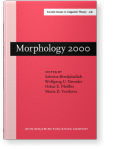Table of contents
1. The lexical bases of morphological well-formedness
2. On category asymmetries in derivational morphology
3. What you can do with derivational morphology
4. How stems and affixes interact: Stem alternants as morphological signata
5. Adjectival past-participle formation as an unaccusativity diagnostic in English and in Polish
6. Morphophonological alternations: Typology and diachrony
7. Morphology, typology, computation
8. On contrastive word-formation semantics: Degrees of transparency/opacity of German and Hungarian denominal adjective formation
9. The acquisition of German plurals
10. Language-specific effects on the development of written morphology
11. Graded semantic and phonological similarity effects in morphologically complex words
12. Passive in Arabic and English
13. Lexical access in Bulgarian perfective vs. imperfective verbs
14. Inflectional morphemes as syntactic heads
15. The problem of morphological description of verbal forms ambivalent between finite and nonfinite uses
16. “Anomalies” of cross-reference marking: The Alutor case
17. Is there a morphological parser?
18. External and internal causation in morphological change: Evidence from Italo-Romance dialects
19. Towards a formal concept ‘zero linguistic sign’: Applications in typology
20. “Constructional” and “structural” iconicity of noun vs. adjective/pronoun markers in the Slavic nominal inflection
21. Morphological splits Iconicity and Optimality
22. Gender inversion in Romance derivatives with -arius
23. Polysynthetic word formation: Wichita contributions to the morphology/syntax debate
24. On the mental representation of Russian aspect relations
Language index
This article is available free of charge.
